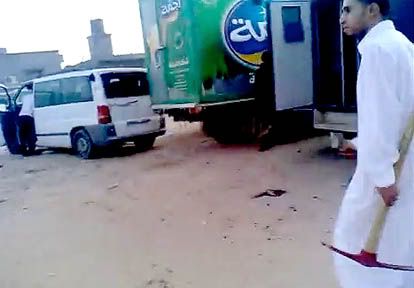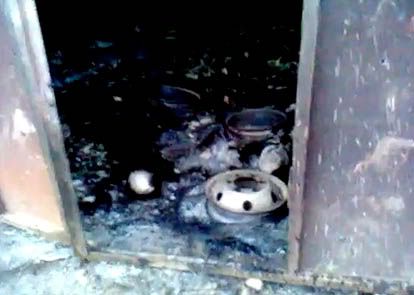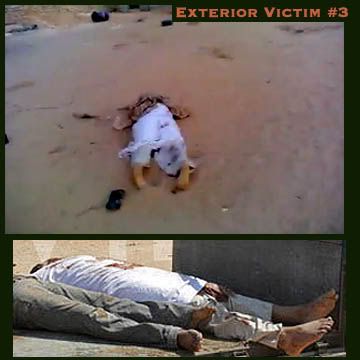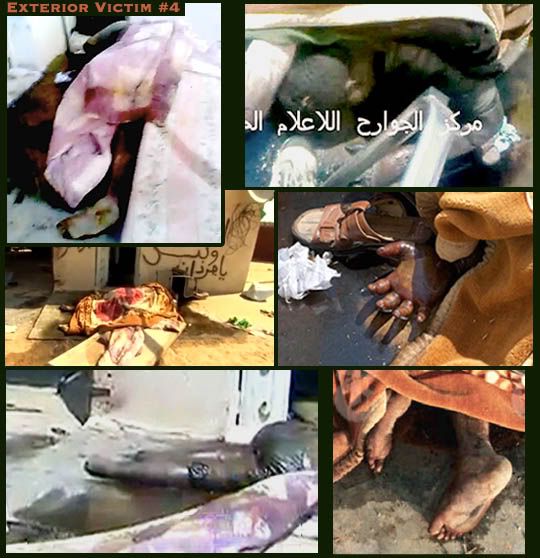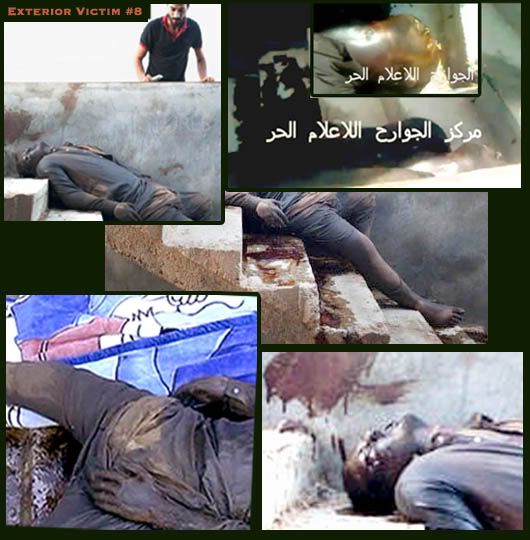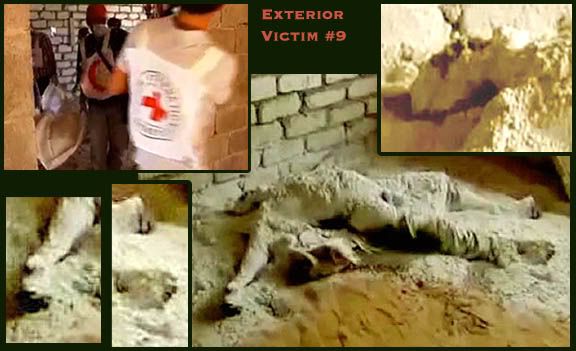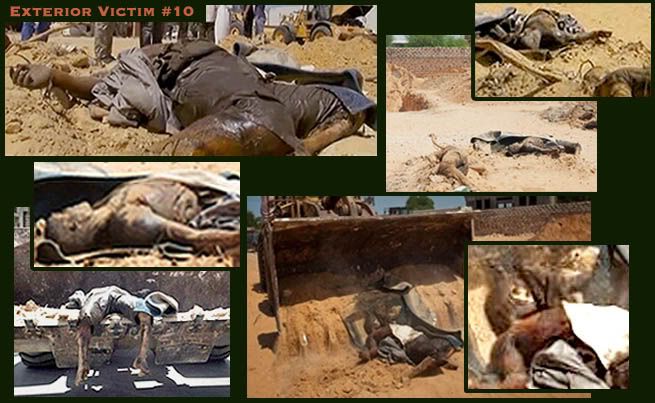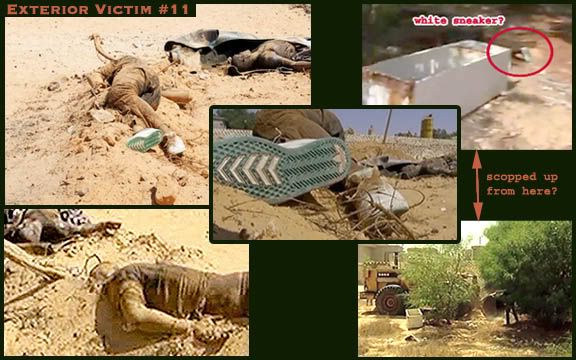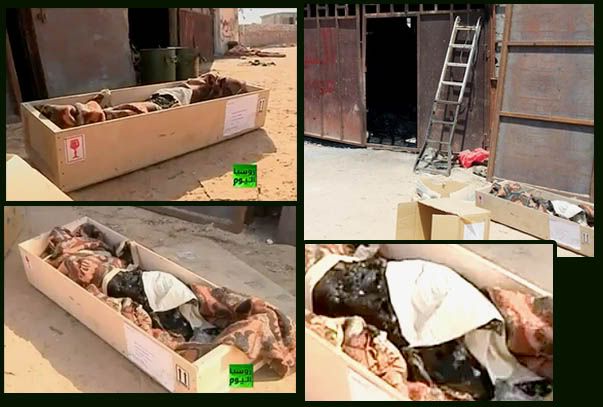last update May 18, 2012
<< The Tripoli Massacres
Note April 7: This post is kind of clunky. I just organized into a sharper package for the report I'm wrapping up. That's up here now, a better read than this, which I'll leave for whatever it's got the other doesn't.
This minor massacre is said to have occurred near the Yarmouk military base in the Khalet al-Ferjan area just south of Tripoli. It's linked closely in time and space with the "Khamis Brigade shed massacre," allegedly carried out behind that base five kilometers away, by most sources. 150 or more citizens of suspect loyalty were reportedly killed at Yarmouk, and only five at its nearby neighbor, the Qasr Ben Ghashir military camp.
I don't have a precise location, but Google maps has a "Qaser Ben Ghashir" which seems to be the airport. There's also a town, Bin Ghashir, next to it. The whole area (map link) is closer to ten kilometers from Yarmouk, south on al Hadhbah road.
I've had contributors bring up this case with due incredulity, but only now that I thought about it more closely do I feel annoyed enough by its patent dishonesty to finally write this. There are other details to be had, but I'll start with Amnesty International's report of August 26 to see what the slaughter-happy NATO rats told them posing as escapees (it's what they pass on as fact).
Killings at Qasr Ben GhashirThe doors of this prison are worth some study. 75 men remained securely locked up for days, weeks, whatever, until five prisoners were killed - not four, but five. And then, miracle it seems to be, all 70 of the others, each apparently in their own cell, managed to break open the doors because they were scared. It seems prison is more in your head than you'd think.
On 24 August, five kilometres away at Qasr Ben Ghashir military camp, guards loyal to Colonel al-Gaddafi shot dead five detainees whom they were holding in solitary cells. They were among some 75 people captured during the conflict who were being held at the military camp.
Former detainees later told Amnesty International that they had heard guards opening five of the cells before gunshots were fired shortly afterwards.
Detainees panicked and broke out of their cells fearing they were about to be executed.
They must have done it pretty close to the same time and showed their free numbers, since the guards fled at this time (or just before - see below). If they'd come out at different times, the guards would have just shot the first few as they escaped and the rest might decide not to escape. That would ruin the story.
Incidentally, Amnesty does not say how many of the implied 70 survivors they spoke with other than giving them in plural form, and doesn't give their names or any details, or provide any direct quotes from them.
Continuing:
By the time they got out, the five guards on duty had fled the scene, leaving behind the five victims’ bodies.They didn't have to put those two fives quite so close together. Five equals five and that's worthy of note here. Maybe it's the rebel way of convincing themselves they weren't really lying, just being poetic, speaking "deeper truths" using symbols (there's a rebel inside every loyalist, Gaddafi loyalty is like a prison, death is a kind of escape, etc...). And besides, it doesn't even make physical sense. How could anyone take it as the literal truth?
On the five who were killed, as opposed to the five who just disappeared (like many did at Yarmouk), Amnesty was told and repeated as fact that:
They included three men from Zliten, a town between Tripoli and Misratah, and two doctors. One of the doctors is believed to be Ali al-Darrat, from Misratah, who was taken prisoner near the eastern frontline in July and had not been heard from since.This alleged captive Mr. Darrat is also mentioned here until I write it in here. His is an odd case, confused with the shed massacre, perhaps killed months earlier, under quite murky circumstances.
Capping AI's exercise in folklore are a few details of whodunnit and what promises they broke, poetically equating freedom and death in the minds of the vanishing cartoon villains.
Former detainees told Amnesty International that in the days before the killings, guards promised that all detainees would be released before the Eid festivities at the end of August.
Both the Khilit al-Ferjan and Qasr Ben Ghashir camps were reportedly used by the Khamis Katiba brigade, headed by Khamis al-Gaddafi, Colonel al-Gaddafi’s son.
What I think happened in reality, in case it's not clear yet, is that a team of about 70 fighters, presumably from among the Misrata brigades, swept through the camp, imprisoned whoever, and killed five or so presumed Khamis brigade members. Perhaps more were killed and re-located, but this is what they decided to credit at the one site. Then they made up a story in which all the team participated, in alternate roles as prisoners, with the slain soldiers doing the same. They all had been prisoners together, in a sense, and were all now freed, in a way.
Ragai's Story
A rather expansive article from the New York Times, Sept.21 by Robert F. Worth introduces another character, Jamal al-Ragai, an escapee from either this massacre or one remarkably like it. He has a rather different story that makes a bit more sense, but also coflicts in key ways with what numerous witnesses told Amnesty a month earlier.
Jamal, according to Worth, "was a 31-year-old manufacturer of uniforms for Qaddafi’s army" until the uprising this year began. He decided to rebel and started with propaganda, then started making bombs and importing weapons from Tunisia, he says, eventually forming a small team of fighters in the capitol. As of September 21, Ragai "had a militia of about 70 men, many of them veterans of bloody street battles in Misrata and other towns, and he was still running operations against Qaddafi hideouts." It's when he started this hunting in Tripoli that's in question here.
Al Ragai's men clearly held him "in high esteem," Worth noticed, and they said he was "known for his bravery and generosity," always sharing the small amounts of water they were allowed in jail, together.
Between his early activism and his later hunting of loyalists, when a lot of build-up should have been happening, Ragai says he instead spent half the time locked away, mostly at what might be the Qasr Ben Ghashir camp. He was arrested in mid-June on his way to weapons pick-up, he says, and taken straight to the shed behind the Yarmouk base. He displays quite a freak-show of psycho-babble about the treatment dished out there, including genital torture by a bald black woman. Emasculating, infuriating, pure propaganda gold.
In a sense, Ragai was lucky: he was transferred from the Yarmouk prison, where the massacre later took place, to a smaller jail not far away, on the grounds of a construction company. He was there on the evening of Aug. 20, when the uprising broke out in Tripoli. Ragai told me he knew instantly that everyone in the prisons would be killed if they did not escape right away.Okay, that's either another bizarre scenario of the same exact type near Yarmouk, three days before the other, or it's a very different version of the same thing. The guards must have left behind the keys as well.
[...]
Early on the morning of Aug. 21, the guards opened the door of the cell next to Ragai’s and led out six prisoners. Ragai told me he spoke to one of the guards, a man named Munir, whom he had befriended. It was a last chance. [...appeal to Libyan identity, appeal to Islam, no effect...] Ragai asked him if he could go to the bathroom. The guard let him out. Minutes later, the men heard gunshots. The six men were being executed. But at the same time, Ragai realized that the guard had left him in a cell that could be opened from the inside. [Yes, one of those jail cells] He got out, and began releasing all the remaining men, who fled the compound. The guards did not even try to stop them; instead, they piled into cars and began fleeing themselves.
After his early release, it gets no smoother. Worth says the aspiring rebel "borrowed a car from a man he met near the prison," drove up to Tajoura, "reunited with his old rebel friends and joined the Tripoli uprising." They did helpful things for a couple of days it seems, and then as soon as rebels started winning, I guess after the 23rd, "Ragai’s own concern, he told me, was to free the 150 prisoners at Yarmouk." Too bad he didn't think of it sooner, as they were allegedly killed at sundown on the 23rd.
"Ragai gathered as many men as he could, and a large group of seasoned fighters from Misrata joined them. Soon they had a force of about 150 cars, and they drove west toward Yarmouk in an armed caravan." It was only then that he hooked up with the Misratans he was commanding a month later. Got it. They did this only on the 25th (Worth says the massacre happened two days earlier). "At about midday, Ragai said, he got a call from one of the other fighters on his cellphone. The man had reached the Yarmouk prison and seen the deserted grounds. “It’s too late,” the man said. “Everyone is dead.”
So this alleged discovery of the dead inside the abandoned base happened prior to the rebels' various acknowledged conquest times (mid-day 26th, night 26th, or mid-day27th). Not that any of this actually happened. It just shows the alternate timeline the rebel fighters are working with compared to what they've told the rest of us.
"Ali"
Just found this December report, in PDF form, from "Physicians for Human Rights" 32nd Brigade Massacre.pdf: It featured two new shed massacre escapees, with elaborate retellings of torture, ridiculous escape stories, and a heroic guard they both mention but no one else does. Of interest here is "Ali" (pseudonym) who was held at Yarmouk "about 80 days" before being transferred, with 21 others, to the camp/construction yard.
PHR interviewed “Ali” (pseudonym) on 10 September 2011. Ali was initially detained sometime in mid-April 2011 at the warehouse in the Agricultural Compound at Khalat Al Forjan. He was then transferred in early August to another makeshift prison, apparently located on the premises of a Brazilian construction company (Odebrecht) located in Guser Bin Gashir, Tripoli, where he was a witness to six summary executions of detainees.As Ragai said, the cells were larger than the original version, and held more than one person each. They were beaten daily, until the day of the massacre three weeks after his transfer:
Early on the morning of 21 August, a guard (name withheld) called out for two doctors and four other detainees from the group. They were blindfolded and led outside. Ali heard a round of gunfire and believed the guards killed the two doctors and four detainees. Everyone inside the cells panicked. “We all cowered against each other fearful of what was about to happen. Then nothing. The guards had run away. I don’t know why they killed those six men.”So now we have a sort-of explanation for the five/six prisoners discrepancy, but also multiple witness confirmation of both given cell types, and both incident dates, and both versions of the sixth man (worthy of mention and not). The corroboration is among batches of witnesses who testified together. The discrepancies are between groups who didn't bother co-ordinating stories. So it must've happened twice, by "Human Rights" logic. Anything else would cast doubt on multiple witnesses by trying to decide just which version actually happened.
Forty-five minutes later Ali and the other detainees slowly emerged from the cells at the Odebrecht facility and found five detainees shot and killed and one other gasping for breath. Ali said that there was no hope for this man as there was no way to transport him or to get help. Some 50 men came out of that detention facility, and walked about one kilometer from the construction company compound where they had been detained.
Ali walked for a while and eventually found a ride from Tripoli to Zawiya. He left around 8:00 a.m. and arrived home at almost 2:00 p.m. When Ali got home, his family was overjoyed as they thought that he had been killed.
A Mass Grave
Also, see comments below - video of a possible mass grave exhumed in the area in early September. I suspect there were more than five people buried here, a little ways away from the prison.
Updates, April 4 2012:
The UNHRC’s report of March 2 (download link) discussed this incident, saying "Six detainees, including three medical doctors, were shot a day earlier in a second warehouse, a few hundred metres away. Three of the six died." They have a lower death toll of three, and a different sounding prison -a "warehouse" people were simply locked in, as opposed to numerous solitary confinement cells. "Earlier"and "away" are relative to the Yarmouk massacre of August 23. They have the location sort of right (“an abandoned warehouse which had belonged to a Brazilian Company”), but far closer than the roughly nine kilometers distance it really was. And the date - we have the 21st from Ragai and from Ali, the 24th from Okok, but no one previously cited the 22nd.
On 22 August 2011, in the morning, a detainee interviewed by the Commission heard Sergeant [030] talking on his mobile phone and saying that there were a large number of detainees. [...] [030] told them to execute the doctors and the “officers” and lock the others inside the warehouse.Settling on the 22nd is exactly as if someone averaged the previous dates. 21 + 21 + 24 = 66, divided by three is 22. Someone decided the truth was between these and told the UNHRC that, which they accepted and passed on as fact. It was corroborated by two of the five guards who fled, who arrived at Yarmouk on the 22nd, saying they had "performed the assignment" at Qasr Ben Ghashir.
At around 10-11 am, one of the guards, a soldier from the 32nd (Khamis) Brigade, [040] came to the warehouse and took six detainees outside. After less than an hour the witness heard the sound of shooting.
Apparently there was no massacre part of the task, just the first6 people shot, deador alive, didn't matter, and the others were simply "locked in," meaning able to open the doors and leave once the guards had departed. (As for the "officers," see update below)
Part of the corroboration is an interesting tidbit for another subject. The quote above, without the [...]:
184. On 22 August 2011, in the morning, a detainee interviewed by the Commission heard Sergeant [030] talking on his mobile phone and saying that there were a large number of detainees. One of the guards recalled how [046] called [030] around 0700hrs , informing him that the thuwar had reached Salahadeen. [030] told them to execute the doctors and the “officers” and lock the others inside the warehouse.Rebel fighters in Salaheddin, if not the district including Qasr Ben Ghashir, then the area of the Yarmouk base, as of 0700 on August 22? Despite this being probably a bogus story, there can be bits of true fact imbedded within it, giving us rare glimpses behind the scenes.
Also, a spot of confusion on victims and escapees. Amnesty Int'l’s report of Aug. 26 seems to be quite similar to this same-day report from the Washington Times, citing Mahmoud Okok, a 29-year-old engineer, as the witness who had survived to tell what happened. He says he was arrested in May on suspicion of giving coordinates to NATO. The report said “Early on Wednesday morning [the 24th], guards dragged six men, including two doctors, from solitary confinement and executed them with their Kalashnikovs, according to accounts.” Okok told them “[the] detainees panicked when they realized that the guards were planning to execute them all. They managed to break out of the prison." Compared to Amnesty's “detainees panicked and broke out of their cells fearing they were about to be executed,"they might have talked to the same guy.
They also added, possibly from Okok, this interesting passage:
“One of the doctors is believed to be Ali al-Darrat, from Misratah, who was taken prisoner near the eastern frontline in July and had not been heard from since.”A now-obscure article run briefly in several Canadian news sites (partial existing re-post here) cited the death of a onetime Ottawa resident, Abdulhamid Darrat, also missing for a long time. His body found in the Khamis shed, and somehow identified, and this fact reported by the 26th, the same day the rebels claim to have first taken the base. It was said he’d been arrested in late May, apparently held at Yarmouk, not the other prison, and killed there with the others. However, as the report said
[Darrat’s daughter] Khadija “said Usama Okok, a family friend who worked with Darrat and was also taken captive in May, told them a different story. Apparently Darrat was beaten and killed only a few days after he was taken captive.”
With two Darrats dead (the doctor and the computer guy) between the two alleged prisons, and two Okoks (Usama the computer guy and Mahmoud the engineer) possibly telling the story of how, this portion of this side-story (which I'm now working into the shed massacre report as a presage) has gotten too confusing to sort out in full. Unless someone helps with that.
Updates May 13:
A while back, Petri Krohn found an excellent resource (see comments below); the Maktoobblog had a report from early on August 26 from a "correspondent" in Qasr Ben Ghashir (QBG). This lists six victims, four of them military officers and two doctors. Roughly translated from Arabic, it seems to say:
Six bodies of martyrs were recovered by the fifth column at the location of the Brazilian company's corporate complex in Qasr bin Ghashir. The names:Thanks to Petri for setting me straight on f). Google translate gave a last name spelling Zleoppe, but that's an alternate and quite different transliteration for the name otherwise rendered Salhoba/Salhouba, as his brother Nasser Salhoba gave when talking to Robert F. Worth (see below).
a) Brigadier M'Hamed Aldberza – "العميد امحمد الدبرزي"
b) Brigadier Mohammed Al-Massoud – "العميد امحمد الاسود"
c) Colonel Dr. Uh Mahmoud – "عقيد محمود دراه"
d) Colonel Miftah Futaisi – "عقيد مفتاح الفطيسي"
e) Dr. Ali Alzerat – "الدكتور على الظراط" – [the correspondent's father] Parents were made mockery of by the battalions at the moment of arrest. ...the battalions slapped and humiliated in front of the people of Qasr bin Ghashir, may Allah have mercy on him.
f) Dr. Omar Salhoba – "الدكتور عمر سلهوبه
One familiar name appearsfor e): "Alzerat my father, Dr. Ali" By the d-dz-z connection, "Alzerat" is apparently Al-Darat, the correspondent's own father. This is apparently not his Ottawa-based daughter; it's posted by (auto-translated) Ketbhaadel Alriqiei, on August 26, 2011 time: 3:33.
As an aside until I understand the meaning, five more names are listed -taking Petri's auto-translation:
The names of the dead from [Mnfdan (?)]:Update: I still don't feel like I understand what "from Mnfdan" means, but Hurriya helps, pointing to a video (#21 on Petri's Libyan Rebels playlist) where it's associated with the Al-Andalus neighborhood (Hay Andalus). This is supposedly a higher-class neighborhood where regime loyalists were known to live, supposedly attacked by prisoners from Abu Salim released when NATO bombed the facility's gates. The Andalus aspect is worth a separate post I just created.
1) Mohamed Abdel-Qader Tagouri –"محمد عبد القادر التاجوري" – a police officer known as a keeper over Alsberati.
2) Abdul Salam Altarhuni–
3) Wajdi Zawi – "وجدي الزاوي
4) Ibrahim Allohh Tagouri – "ابراهيم اللوشة التاجوري"
5) Hamza Al-Surmani [Google gives Abmana - thanks to Hurriya for correcting me] – "حمزة الصرماني" – follower of Mohamed Mansour Dou
Robert Worth, in a recent New York Times Magazine article (analyzed here), wrote of a doctor named Omar Salhoba, aged 42, killed at "the hangar" on late August. His name appears on the above list, and again he's grouped with another doctor and four officers. A cousin of his alleged executioner, Marwan, was told "‘Your cousin killed six very qualified people whom Libya will need, two doctors and four officers."
But many details in Worth's report suggest that he's supposed to be a prisoner at Yarmouk, not Qasr Ben Ghashir. These six were given as the first killed among many at one location, as opposed to the maximum number killed at the other. As Mr. Worth wrote: "It was Marwan who shot Omar and the other five victims first; the other two guards fired only after Marwan emptied two clips from his AK-47." Were the two clips used against only those six? Who else did they shoot afterwards at this place where, it was previously said, 50-70-100 other prisoners walked away unharmed after four to six killings?
Omar was specified as one among the "prisoners at the Yarmouk military base, where perhaps the most notorious massacre of the Libyan war took place..." Marwan was one of the guards at Yarmouk who "were perfectly open about their roles at Yarmouk." Asked by his interrogator (Dr. Omar's brother, Nasser Salhoba) about the six, he suggested they were part of a much larger collection of victims in "the hangar," sounding like the famous Yarmouk ones:
Nasser: “During all that month after Tripoli fell, did you think about the six people you executed?”
Marwan: “I did think about them and also about the prisoners who were killed and burned in the hangar.”
Nasser: “But this was different. You executed these six people yourself."
Before killing these first six, Marwan said, “we brought them from the hangar and put them in a small room." Is "the hangar" the same in both cases? Unclear.
Nothing in the article places the prisoner Omar at QBG by name, and that second prison isn't named at all, despite the escape of one Worth's main subjects from that locale (Jamal Al-Ragai is back, this time a higher-level commander yet with political ambitions, and now called "Jalal Ragai").
But neither is it clear at all Nasser's legendary brother was is now being claimed as a victim of the shed massacre. That notorious crime was on August 23, as Worth duly notes. But he says Omar was killed, wherever he was killed, on the 24th, as a result of "the events of Aug. 24, when [Marwan] executed Omar and the other five men." Of course, it was Ragai who had first used the date August 21 for his bizarre escape, so what this date refers to is ... confused.
It has been generally reported that both sites were run by the Khamis brigade, with soldiers and prisoners going back and forth. But the location and date of a person's execution can only put them at one or the the other. In the end, QBG wins, with Worth's article merging the two into a general Yarmouk prison, with two branch offices, and two incidents muddled into one. Omar the doctor was revered at Yarmouk for helping the injured. But "whenever they were tortured, they would be brought to his cell so he could treat them.” QBG had cells, not Yarmouk (except in the earliest reports when the locale wasn't yet decided)
Marwan explained that the Yarmouk prison commander, a man named Hamza Hirazi, ordered him by phone to execute six prisoners, including Omar and several officers who had been arrested for helping the rebels. “We brought them from the hangar and put them in a small room,” he said when I pressed him for more details. “The killing happened with a light weapon. We closed the door and left.”
Such order reportedly came down to the Qasr Ben Ghashir prison (from Haziri/Hirazi?), but not the Yarmouk one, where the alleged order was to kill everyone. 17 soldiers, not 4 officers or any doctors, were reported taken out of the Yarmouk hangar first, by two alleged survivors (Fathallah Al-Ashter and Ali Hamouda) who spoke together to Orla Guerin. [OG] No others report anything remotely similar to this at Yarmouk.





